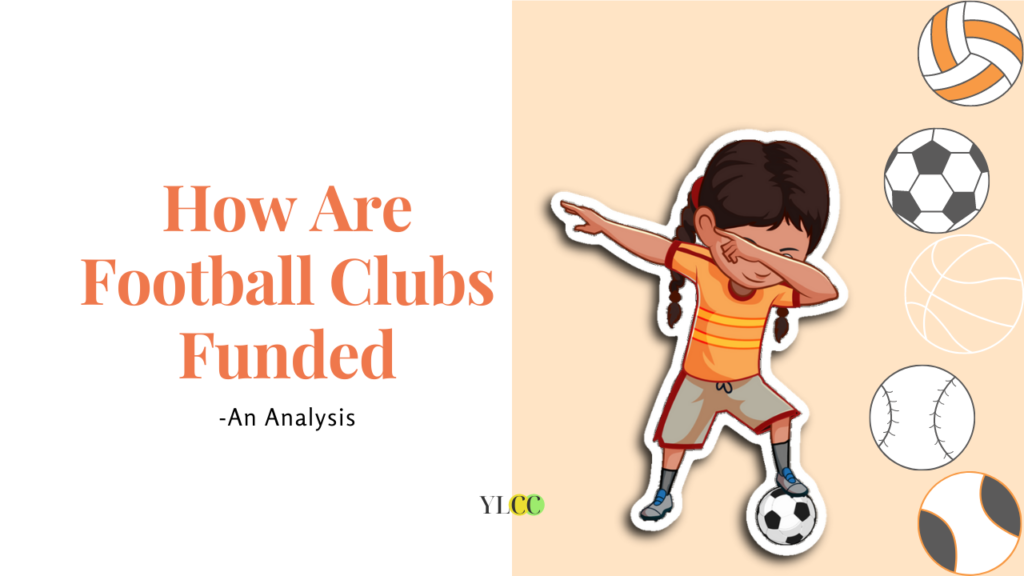
Introduction
According to Statista, Barcelona, a Spanish professional football club’s revenue as in 2021 is $792 million (over 5800 Crores INR) and the least revenue was clocked by AS Roma (An Italian professional football club), which earned $156 million (over 1100 Crores INR). This article aims examine the sources of revenue for football clubs across the globe. The article discusses different sources of finance of football clubs such as player transfer, broadcasting, stadium rental and tours, match day revenue, merchandising and sponsorship.
Player transfer
What is a transfer?
A football player transfers from one club to another through a business transaction between two clubs. The two clubs are called the selling club and buying club. The transaction between them can be called ‘transfer’ and the fees that is paid as compensation to the selling club (as it loses the player and services) by buying club is called ‘transfer fees’.[1] Along with the player, registrations details are also transferred.[2] Transfer fees can be asked for only where the player transfers before the expiration of the contract.[3] Once an agreement is reached at the transfer fees, negotiation between the player and the buying club takes place for discussing factors like wages, image rights, etc.[4]
The amount of transfer fee depends on a number of factors such as the length of the present contract, commercial value, potential worth of the player, perceived quality etc.[5] A medical examination also takes place for checking if the player is fit to play. In case some undetected injuries are found, the transfer fee can be affected.[6]
When do transfers happen?
As per FIFA (International Federation of Association Football) regulations, transfers of foreign players can happen during two annual periods notified by it.[7] This is called the ‘transfer window’. However, the exact timing is decided by football associations of individual countries. For instance, UEFA (The Union of European Football Associations), the governing body for football in Europe allows the transfer window to open two times in a season. The first one remains opened from 1st of July to 31st of August while the second one remains open throughout January. The final day of the window, known as ‘Transfer Deadline Day’ witnesses the maximum transfers.
Different clauses in a player’s contract
There are broadly two important clauses in a player’s contrary determining the amount of money that a club can earn. The two clauses[8] are discussed as follows:
- A buyout clause can be described as the valuation of a player that the club has. If the valuation set out in such a clause is met by a buying club, the selling club has to accept the offer with which the player may move.
- A release clause is an undertaking by the club for accepting an offer for the player in case a bid is received over the pre-determined amount set out in the clause. This acceptance is subject to some conditions such as a specific date, non-participation in a particular league, etc.

How does the transfer work in different countries?
In countries like Canada, America, and Australia, the buying club, along with the player transfer, purchases the player’s original contract from the selling club. On the other hand, European clubs prefer the old contract to be terminated and a new contract is entered into between the club and the player.
Spanish player contracts have been given a right to have a buyout clause, codified under Spanish law. Thus, the players have the right to buy out their contracts either at a price set out by a court or stipulated in the buyout a clause.[9] In India, there is an option of player transfer either through a buyout clause or through negotiation of transfer fees.[10] The main distinction is that under Spanish legislation, the payment is made by the player himself, not by the buying club.[11]
Broadcasting
For football clubs, the sale of broadcasting and media licenses is one of the biggest sources of revenue as the clubs get paid huge sums of money by television and media organizations. Media houses get the right to broadcast top sporting events live while clubs get to generate funds for organizing sports events, bringing development in sports, refurbishing stadiums, etc.[12]
The importance of broadcasting in view of revenue generation can be judged by the European football league’s complex tender process, in which broadcasters compete to have the rights to broadcast the game and become the official rights-holder of the game or tournament. When it comes to the English Premier League, it operates on a centralized distribution model, which means that the revenue generated through broadcasting rights is distributed among all the clubs. It is important to note here that the rights owned by football clubs are licensed centrally to potential buyers and the constitution of the Premier League governs the ownership, rights, and licensing system. However, selling these rights to third parties is not allowed.[13]
In the United Kingdom, broadcasting rights have been awarded to BT, Sky Sports, BBC, and Amazon till 2025. Apart from this, in China, there are 20 broadcasters having rights to cover the Premier League. Across the world, there are over 100 broadcasters with such rights.
Stadium rentals and tours
Football clubs use stadiums on 6 other days, other than the match day by hiring out their facilities and offering various packages.[14] The packages are designed mostly for weddings, private social events, museum and stadium tours, etc. Some clubs even offer a chance to play a match at the stadium with friends. However, this offer is mostly not given by strictly professional football clubs. Apart from this, concerts have also been organized by some clubs. In recent years, stadiums, like the Stadium of Light (Sunderland FC) and the Millennium Stadium (Wales National Team Stadium), have hosted concerts. Carrow Road (Norwich City’s home pitch) can be visited for playing a private match with friends.
Matchday revenue
The day of the match is the most important day for the football clubs to earn money. This day’s revenue can be broken down into three elements: Setting up of prices on various services like food and drinks, ticket sales, and hospitality experience.
Ticket sales include selling tickets to the individuals that enter the home stadium to watch the match. The determination of the revenue earned is done based on the size of the stadium and the price of the ticket. Needless to say, bigger stadiums are able to earn more money. Imagine how much the football clubs earn when each team of the Premier League plays 19 times in the home stadium.[15]
Another source of match day revenue generation is the sales of food and drinks. As clubs are in charge of setting their own prices for food items like hot dogs, pies, tea, beer, and other match day programmes, it is a great source of revenue too. In the 2019/20 season, the price of a pie at each of the EPL stadiums ranged from £2.9 (Liverpool FC) to £4.5 (Chelsea FC).
When it comes to providing a hospitality experience on the day of the match, business people are a great source of earning revenue. These people look for comfortable seats, executive lounges, boxes with a view of the pitch, and many such things. Clients are ultimately paying for an experience. The aromas, flavours, and textures of freshly prepared food are a great way to make a memorable experience for visitors.[16]
Arsenal Football Club charges £891 per head, the most expensive match day ticket. Other clubs like Tottenham Hotspur, Liverpool, Chelsea, Wolves also charge more than £540. With a capacity of 74,994, Manchester United’s home field, Old Trafford, is the premier league’s largest stadium.
Merchandising
Almost one in every two people in the world is a football fan and the football clubs take advantage of it by selling kits and other club merchandise to such fans. Whenever you see a Jersey being sold around the stadium or a club has its own store, all of it is merchandising. Merchandising brings millions to the club while allowing fans to purchase almost every product from towels to cups.
Many clubs have even started offering online sales for those who want to purchase directly from them rather than from sports stores. This has a high chance of resulting in repeated sales. Selling football shirts is the biggest type of merchandising because if a famous football player transfers, the club can sell its shirt with the player’s name and number on the back for a huge sum of money since it knows people would purchase it.[17]
Sponsorship
Sports sponsorship is a major business. Football clubs get the funding they require by entering into sponsorship agreements with sponsors and endorsing their products or services. Football sponsorships are termed “symbiotic relationships” by scientists as betting companies profit from brand marketing and exposure while clubs gain from the huge sums of money they get.[18] Many times, agreements even go beyond jersey sponsorship deals. TV advertisements with a franchise player are also created sometimes. Even sportsbooks advertise on social media accounts of the football clubs. These extra partnerships lead to clubs earning a lot of money. [19]
The top football sponsors in the world are Nike, Barclays, Coca-Cola, Pepsi, Adidas, and Red Bull, and Samsung. If we take the example of Manchester United Football Club (MUFC), the home kit worn by players during the 2019/20 season was sponsored by three different companies. The companies were Chevrolet (£64 million), Kohler, and Adidas (£75 million). If we break that down, MUFC receives up to £10 million, £75 million, and £64 million from Kohler, Adidas, and Chevrolet respectively.

Conclusion
Apart from the above discussed methods of raising finance as undertaken by football clubs, it is important to note that most of the clubs are now connecting with football fans using social media networks like Twitter, YouTube, Instagram and even through OTT platforms like Netflix or Amazon Prime. For instance, the Amazon Prime documentary “All or Nothing: Manchester City” is a sports franchise documentary which came out in the year 2018. In conclusion, it can be reiterated that popular sports like cricket and football are indeed revenue-rich sectors and the investment is only expected to grow in upcoming years.
[1] Football Player Transfers Explained, FOOTBALL STADIUMS, https://www.football-stadiums.co.uk/articles/football-player-transfers-explained/.
[2] How does a football transfer work? From Players to agents, clubs to leagues, GOAL, (Jan 29, 2020, 18:30), https://www.goal.com/en-in/news/how-does-a-football-transfer-work/130og8e76770l1dcqbne3jntx7.
[3] Supra note 1.
[4] Nikhil Srivastava, Buy-out clauses and how they work in Spanish football, SPORTSKEEDA (May 27, 2015),https://www.sportskeeda.com/football/buy-out-clauses-how-they-work-spanish-football.
[5] Supra note 2.
[6] How does a football transfer work?, BBC, https://www.bbc.com/worklife/article/20170829-how-does-a-football-transfer-work.
[7] Ibid.
[8] Supra note 4.
[9] A Guide To The Key Legal Issues In The Football Transfer Window, LAWINSPORT (Aug 10, 2015), https://www.lawinsport.com/topics/item/a-guide-to-the-key-legal-issues-in-the-football-transfer-window.
[10]Vishakh Ranjit & Anirudh Rastogi, India: Step-by-Step Guide For The Transfer Of Football Players In India, MONDAQ (July 2, 2020), https://www.mondaq.com/india/employee-benefits-compensation/958988/step-by-step-guide-for-the-transfer-of-football-players-in-india.
[11] Supra note 8.
[12] Olisa Agbakoba Legal , Understanding Commercial and Media Broadcasting Rights in Sports, LEXOLOGY (May 21, 2021), https://www.lexology.com/library/detail.aspx?g=7c333e57-e419-472a-a6f9-98136a3578af.
[13]Ibid.
[14] How Football Clubs Make Money, FOOTBALL ICONIC (Sept 29, 2020), https://footballiconic.com/how-football-clubs-make-money/.
[15] Charles Temitope, HOW DO FOOTBALL CLUBS MAKE MONEY ?, MEDIUM (Jan 13, 2018), https://medium.com/@topebush/many-lovers-of-the-beautiful-game-of-football-still-cant-wrap-their-heads-around-how-clubs-afford-d6a2f5c93d36.
[16] Adam Corre, Paul Linden Catering assesses the importance of match-day revenue for Premier League football clubs, AT THE MATCH, https://atthematch.com/article/paul-linden-catering-assesses-the-importance-of-matchday-revenue-for-premier-league-football-clubs.
[17] The Effects of media & technology in Football, https://mediaandtechnologyinsport.weebly.com/increase-merchandising.html.
[18] Seven Lessons from the Growing Trend of Football Sponsorships, KEEP IT ON THE DECK (NOVEMBER 11, 2020), https://keepitonthedeck.com/blog/2020/11/11/seven-lessons-from-the-growing-trend-of-football-sponsorships.
[19] Ibid.
YLCC would like to thank Aditi Aggarwal for her valuable inputs in this article.







